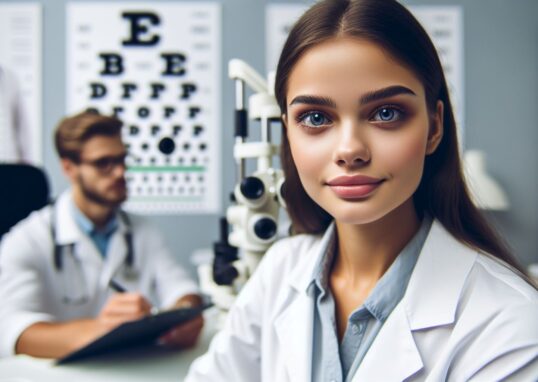
Age-related macular degeneration (AMD) is a medical condition that primarily affects the central part of the retina called the macula, which is responsible for sharp and central vision. This essay explores whether AMD affects one or both eyes, drawing on information from various health organizations.
Understanding AMD and Its Types
AMD comes in two main types: dry (atrophic) and wet (neovascular). Dry AMD is more common and progresses slowly, leading to a gradual loss of central vision. Wet AMD is less common but more severe and can lead to rapid vision loss.
Does AMD Affect Both Eyes?
The question of whether AMD affects both eyes is crucial for understanding the disease and its impact on patients’ lives. The answer is not straightforward, as AMD can present differently in each individual.
One Eye or Both?
AMD can start in one eye and eventually affect both, but it does not always follow this pattern. Some patients may experience AMD in one eye for a long time before it develops in the other. In other cases, both eyes may be affected simultaneously, but with varying degrees of severity.
- Bilateral Involvement:
- While AMD often affects both eyes, there are cases where it remains unilateral, impacting only one eye.
- However, based on current literature, unilateral AMD develops into a bilateral condition in approximately 10% to 20% of cases.
- This means that about 18% of patients initially diagnosed with unilateral AMD eventually experience AMD in their fellow eye.
- Timing of Second Eye Involvement:
- Researchers found that within two years, approximately 60% of patients with unilateral AMD develop AMD in the second eye.
- In some cases, this progression occurs even within six months.
- Regular monitoring of both eyes is crucial to ensure timely treatment and improved visual outcomes.
- Early Diagnosis:
- Interestingly, the second eye often has a higher best-corrected visual acuity (BCVA) at the start of treatment compared to the first eye.
- This suggests a greater likelihood of early diagnosis if the patient’s first eye is still being treated and regularly examined.
Age-Related Macular Degeneration (AMD) affecting one eye while sparing the other can be attributed to several factors. Let’s explore some possible reasons:
- Asymmetrical Disease Progression:
- AMD doesn’t always progress symmetrically in both eyes.
- The disease may advance more rapidly in one eye due to variations in genetic susceptibility, environmental factors, or other individual differences.
- Factors like blood flow, oxidative stress, and inflammation can impact the macula differently in each eye.
- Genetic Variability:
- Genetic factors play a significant role in AMD.
- Variations in specific genes associated with AMD susceptibility may lead to different outcomes in each eye.
- Some individuals inherit genetic variants that increase their risk of AMD, but the expression of these genes can vary between eyes.
- Environmental Factors:
- Exposure to environmental factors (such as sunlight, smoking, and diet) can influence AMD development.
- Differences in exposure levels or protective measures (like wearing sunglasses) may affect one eye more than the other.
- Local Factors:
- Each eye has its unique microenvironment.
- Local variations in blood supply, oxygen levels, and metabolic processes can impact disease progression.
- For instance, blood vessels supplying the macula may differ between eyes.
- Chance and Randomness:
- Sometimes, asymmetric AMD occurs due to chance.
- Random variations in cell damage, immune responses, or other biological processes can lead to different outcomes in each eye.
- Treatment and Intervention:
- Early detection and timely intervention can slow AMD progression.
- If one eye is diagnosed earlier and receives treatment (such as anti-VEGF injections for wet AMD), it may fare better than the untreated eye.
Progression and Risk Factors
The progression of AMD in the second eye is a concern for those already diagnosed with the condition in one eye. Studies suggest that there is a significant risk of the second eye developing advanced AMD over time. Factors such as age, genetics, smoking, and diet can influence the likelihood and speed of this progression.
Impact on Vision and Daily Life
When AMD affects both eyes, it can significantly impact a person’s ability to perform daily tasks that require sharp vision, such as reading and driving. However, it’s important to note that AMD does not lead to complete blindness, as peripheral vision is usually preserved.
Monitoring and Treatment
Regular monitoring of vision changes is essential, especially for those with AMD in one eye. Early detection and treatment can help slow the progression of the disease and preserve vision. Treatments vary depending on the type of AMD and may include lifestyle changes, medication, and in some cases, surgery.
Conclusion
In conclusion, AMD can affect one or both eyes, and the progression can vary between individuals. Understanding the nature of AMD and its impact on vision is essential for managing the condition and maintaining quality of life. It’s important for individuals with AMD to consult with healthcare professionals for personalized advice and treatment options.
Here’s a list of resources to continue learning:
- NIH on AMD: Discusses the risk of second eye involvement in age-related macular degeneration (AMD).
- Mayo Clinic: Provides details on dry macular degeneration, noting it can affect one or both eyes.
- Cleveland Clinic: Offers insights on macular degeneration affecting one or both eyes with varying severity.
- BrightFocus: Answers frequently asked questions about AMD, including its potential to develop in only one eye.
- Johns Hopkins Medicine: Highlights AMD as a common cause of severe vision loss in people over 50, affecting the center of vision.





